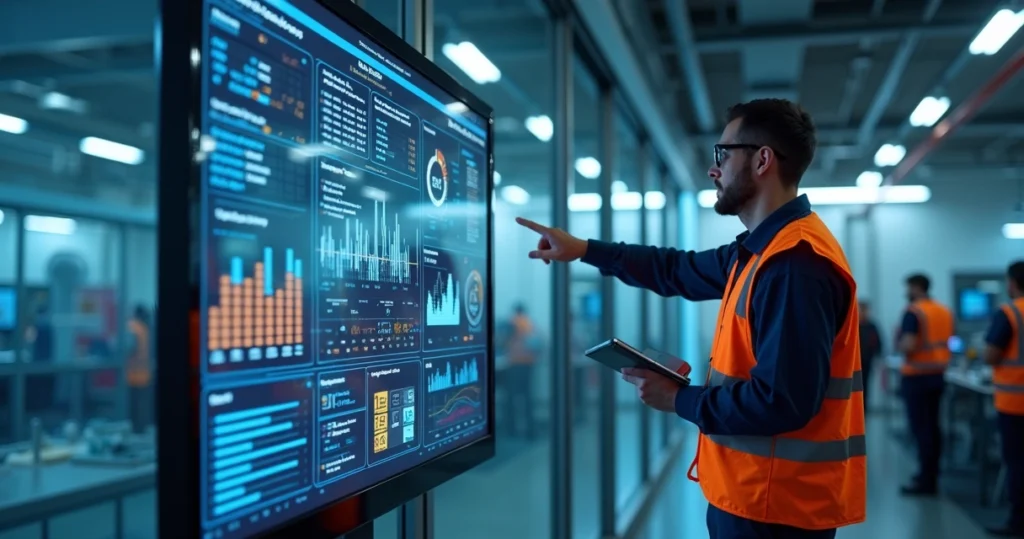How to Prove ROI When Investing in AI for Maintenance

Sometimes, you see a dramatic change on the horizon but can’t quite get everyone else to see it. That’s been the experience for a lot of maintenance teams looking at AI. Many managers see the price tag of AI-based tools, like Prelix, and tense up. Justifying the investment—and proving the return—isn’t always straightforward.
But actually, showing ROI doesn’t have to be a battle. When you break it down, build in a process, and have real examples, you get people on board—whether they’re in the boardroom or on the shop floor. Let me share what I’ve learned along the way.
Starting with a shift in mindset
If you’re considering AI for maintenance, the first thing is to see it not as a cost but as a shift. Think less about spending more and more about losing less—less downtime, fewer failures, fewer compliance headaches. This is subtle, maybe, but it matters.
See investment as a way to stop money leaking out, not just a new line item.
AI platforms like Prelix tend to pay for themselves quickly, especially when you track the right things. And that’s exactly where you start—by knowing what to count.
Finding your starting line: establish a baseline
You can’t measure change without a clear “before” picture. That means documenting what your current maintenance world looks like, flaws and all.
- How much are you spending on maintenance, repairs, and operations (MRO) yearly?
- How many unplanned downtimes do you have each month?
- What’s your mean time to repair (MTTR) on critical assets?
- How many compliance incidents or late reports?
These numbers become the baseline. They are your “old normal.” Many teams doing this are surprised at what they find—hidden costs, silent bottlenecks, expensive patterns.
Projecting the upside: understanding AI’s cost savings
So, what can AI actually return? Real numbers, not just “things should get better.” Let’s anchor in data. According to Deloitte research, companies using predictive maintenance can cut MRO costs by 5–10%, sometimes even up to 12%.
Or take this: Organizations rolling out AI-based strategies often save up to 30% on maintenance costs. That’s not speculation—it’s showing up in company ledgers across different industries.
Imagine saving a third of your maintenance budget. Instantly, AI stops feeling expensive.
These savings usually show up in three ways:
- Less unscheduled downtime, meaning more hours of production.
- Lower parts spend and rushed shipments because failures are caught early.
- Compliance and reporting tasks take less time, with fewer fines or audit risks.

Real-world scenario: a case of sudden returns
I remember an industrial maintenance manager who worried he’d never get sign-off for AI tools. His pitch? He projected, based on their average downtime event, that just one avoided two-day halt would pay for their AI subscription for the whole year. He was right—three months in, an early warning from the AI prevented a failure that would have cost at least five figures in lost production.
Stories like this aren’t isolated. According to industry research, many companies recover their full AI investment within 12–24 months, sometimes faster if equipment is critical or if downtime costs spiral quickly.
Calculating ROI: starting simply
ROI can seem complicated, but it’s just a balance of what you gain versus what you spend. The simplest formula is:
ROI = (Net Savings from AI – Cost of AI) / Cost of AI × 100%
Here’s a quick example, realistic enough:
- AI costs your plant $50,000 per year.
- After six months, unplanned downtime is already down, saving $80,000 in lost production and $10,000 in overtime labor reductions.
- That’s $90,000 gained, minus $50,000 spent = $40,000 net gain.
- ROI = ($40,000 / $50,000) x 100% = 80%
And the year isn’t even done.
Factoring in less direct savings
Sure, some value is harder to put a number to. Faster compliance reporting. Stress avoided for staff. Quicker investigations. Yet some organizations place a value on these “soft” benefits—reducing compliance risk, for instance, by measuring potential fines or lost production during audits. With Prelix, teams often report reports are pulled together 60% faster, and recurring issues are flagged before they cycle around again.
Budget obstacles: ROI even when budgets are tight
When budgets are already thin, investing in something new feels like a stretch. Here’s the advice I give teams:
- Start small. Can you run AI on just your top-failure assets?
- Present quick wins. Document the first prevented breakdown or saved overtime shift.
- Reinvest the savings. Use the first round of reductions to finance further AI expansion.
Sometimes a proof-of-concept is worth more than a thousand spreadsheets.
AI tools like Prelix often allow easy scale-up. The first six months lay the groundwork—and then you can compare, asset by asset, with before-and-after numbers.

Tracking the value: don’t just look at year one
ROI is not a one-time thing. The smartest organizations keep tracking savings year after year. Asset health can keep improving, unplanned downtime stays low, and operational surprises get rarer. Here’s what should go in your regular review:
- Yearly downtime reduction (in hours and lost revenue avoided)
- Total maintenance spend, compared year-on-year
- Compliance issues and reporting speed
- Average MTTR trend
According to studies such as AI-driven predictive maintenance, equipment downtime can shrink by up to 70%. That’s not a gentle slope, it’s a dramatic drop. Combine that with increases in asset utilization—reports mention up to 68%, as seen in industrial research—and you see not just savings but new revenue potential.

Telling the story: communicating ROI to leadership
Numbers need context. Leadership teams are busy, sometimes skeptical, always balancing priorities. Proving ROI means telling a story of change, not just savings. Here’s how to do it:
- Use “before” and “after.” Show the baseline (failures, downtime, costs) right next to the post-AI numbers.
- Highlight the quick wins. Did an AI alert prevent a shutdown? Did you file compliance reports in half the time?
- Show trends, not just one-time wins. Line graphs help—a year-on-year drop in downtime is hard to argue with.
- Share staff feedback. What do technicians notice? Is morale better? Is there less firefighting?
- Remind them what’s at stake. What would missing these gains cost next year, or in lost market share?
It can honestly be awkward at first. Sometimes leaders need more than spreadsheets. Sometimes it takes a walk through the plant to really see what’s shifted.

Tips to boost credibility (and overcome objections)
- Show examples from your own industry. There’s more confidence in “It worked for someone like us.”
- Keep it honest. If some things are still ramping up, say so. Overpromising backfires fast.
- Mention independent research. Quoting studies like those from Deloitte and others puts extra weight behind your numbers.
- Document continuously. Keep a running log of incidents averted, savings, or process improvements—the small ones add up.
- Reference practical guides. There are step-by-step resources for tracking RCA and AI impact, like the Root Cause Analysis with AI guide or for hands-on practical advice, the practical analysis tools from Prelix.
When ROI is more than just numbers
Here’s a detail that sometimes gets missed. ROI is not just a financial number. Sometimes it’s peace of mind. It’s seeing a team troubleshooting smarter, not running on coffee and adrenaline. Compliance audits aren’t as terrifying. Reports take hours, not days. Those things are real, even if your spreadsheet can’t always capture them.
Platforms like Prelix are changing the way maintenance teams work, turning failures into signals instead of stressful crises. For some managers, these are the most meaningful returns of all.
New habits: tracking value year after year
Let’s be honest, the first year might be full of big leaps, but the value keeps growing. Set a review schedule—check in every three or six months. Are the assumptions holding up? Have workflows improved further? Document it, even if it feels small.
If you ever need inspiration or a reset, Prelix’s blog updates with practical stories and advice from real-world users. Sometimes seeing another team’s dashboards or failure log is all it takes to spot new savings at home.
Conclusion: move from proving ROI to living it
Proving ROI with AI in maintenance doesn’t have to be mysterious or hard. Start small. Track the right things. Celebrate the early wins and keep the story running as your team unlocks new savings, solves deeper issues, and gets more confident along the way.
Let the numbers—and people—do the convincing.
Prelix is helping teams shift from guesswork and stress to data-driven decisions that pay off, not just on the bottom line. Will this be the year you turn your maintenance strategy into a source of wins? Reach out, explore Prelix, and see how your team’s story could transform.
Frequently asked questions
What is ROI in AI maintenance?
ROI (Return on Investment) in AI maintenance is the measure of financial or operational value gained from using AI-powered tools, compared to how much you spent to implement and maintain those tools. In maintenance, ROI often tracks reduced downtime, cost savings, faster reporting, or fewer unplanned failures after using a tool like Prelix.
How can I measure AI ROI?
Start by tracking your costs and operational results before AI—minutes or hours of downtime, maintenance spend, number of incidents, and reporting hours. After introducing AI, look for improvements in these numbers. Calculate net gains by subtracting AI costs from the savings or additional revenue, then divide that net gain by the AI cost and multiply by 100% to get your ROI percentage. Don’t forget both direct and indirect savings, like compliance or quicker diagnostics.
Is AI worth it for maintenance?
AI is worth it for maintenance if your team deals with complex equipment, frequent downtime, or rising compliance burdens. Studies show AI-driven maintenance can lower costs, avoid expensive failures, and improve team workflows. If these improvements are greater than the cost of the AI tool, it’s worth the investment. But, it depends on your needs and scale—start with a pilot if you’re unsure.
How much does AI maintenance cost?
Costs depend on vendor, asset count, integration needs, and support level. Some teams start with a few thousand dollars a year for targeted installations, while large organizations may spend tens of thousands or more for full-scale platforms. The key is to compare this cost to the potential or realized savings in downtime, labor, and risk reduction.
What are common ROI metrics for AI?
Common ROI metrics for AI in maintenance are:
- Reduction in unplanned downtime (hours/% decrease)
- Maintenance cost savings (year-on-year)
- Decrease in emergency repairs or expedited parts spend
- Speed of compliance or audit reporting
- Increase in asset uptime or utilization
- Payback period (time taken to cover AI investment)
Pick the ones that matter most for your business goals and track them consistently.
